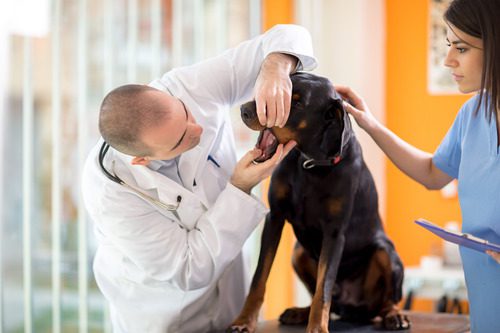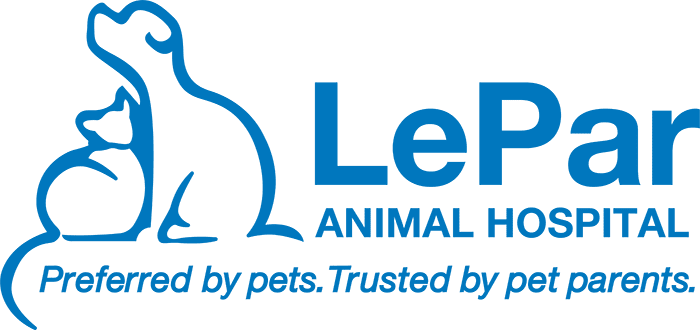Oral Tumors in Dogs: What These Look Like and How They’re Treated
When your dog shows signs of discomfort while eating or develops an unusual lump in the mouth, it can be alarming. Oral tumors in dogs are more common than many pet owners realize, and early detection is key to achieving the best outcome. These growths vary in appearance and behavior. Some are benign and slow-growing, while others are aggressive and malignant. The team at LePar Animal Hospital is here to help you understand what oral tumors in dogs can look like and how they are treated, so pet parents can feel empowered to act quickly and seek the right care. If you’re concerned about changes in your dog’s mouth, this blog will help you know what to look for and what to expect next.

What Are Oral Tumors in Dogs?
Oral tumors in dogs are abnormal growths that develop inside the mouth, often on the gums, tongue, or jaw. These tumors can be benign, growing slowly and remaining localized, or malignant, spreading to nearby tissue or organs. Common malignant types include melanoma, squamous cell carcinoma, and fibrosarcoma. Because early symptoms are often subtle, tumors may go unnoticed until they interfere with eating or cause visible swelling. Regular dental checkups and monitoring your dog’s mouth at home can help catch problems early and lead to more effective treatment.
Signs and Symptoms of Oral Tumors in Dogs
Oral tumors in dogs can present a wide range of signs. Some are clearly visible, while others may only be discovered during a dental exam. Regardless of tumor type, any change in your dog’s mouth should be taken seriously.
Common Signs to Watch For:
- A visible lump or swelling inside the mouth
- Bleeding from the mouth without injury
- Bad breath (often persistent and foul)
- Difficulty chewing or reluctance to eat
- Dropping food from the mouth
- Loose teeth or teeth that seem to shift
- Excessive drooling, possibly tinged with blood
- Weight loss over time
Many of these symptoms overlap with other dental conditions, such as periodontal disease, which makes professional diagnosis essential. If your dog shows any of these changes, a veterinary exam should be scheduled promptly.
What Oral Tumors in Dogs Look Like
The physical appearance of oral tumors in dogs can vary significantly based on the tumor type and stage. Some tumors look like swollen areas of the gum, while others resemble warts, ulcers, or cauliflower-like growths.
Types of Tumor Appearances:
- Melanomas: These can be darkly pigmented or non-pigmented and appear as raised masses on the gums, lips, or roof of the mouth.
- Squamous Cell Carcinomas: Often found on the gums or tongue, these tumors may look ulcerated or raw and tend to bleed easily.
- Fibrosarcomas: These tumors can appear as firm, fleshy masses and may not be visibly aggressive, even though they can invade deeply.
- Epulides: Common in older dogs, epulides grow along the gumline and may resemble a firm nodule or lump between the teeth. While these can be benign, there are other types that can be invasive and locally destructive and need to be addressed by your veterinarian.
If a growth is visible, your veterinarian may recommend imaging and a biopsy to determine the type of tumor and whether it has spread to other areas.
What to Expect During an Oral Tumor Diagnosis for Dogs
A veterinary diagnosis is essential for understanding the nature and severity of oral tumors in dogs. The process usually begins with a physical exam and oral inspection, followed by diagnostic testing to learn more about the growth.
Common Diagnostic Steps:
- Oral Examination: Your vet will inspect the mouth and assess any masses or abnormalities.
- Dental X-rays: These help evaluate how deep the tumor extends and whether bone is involved.
- Fine Needle Aspirate or Biopsy: A tissue sample is taken to identify the tumor type and determine whether it is malignant or benign.
- Blood Work: Helps evaluate overall health and whether the body is reacting to an underlying disease.
- Chest X-rays: These check for signs of metastasis, particularly in the lungs.
Diagnosing oral tumors in dogs requires a thorough and strategic approach. Accurate identification leads to better treatment planning and prognosis.
Managing Oral Tumors in Dogs: Treatment Options
Treatment for oral tumors in dogs depends on the type, size, location, and whether the tumor has spread. In many cases, a combination of surgery and additional therapies is necessary.
Surgical Removal
Surgical excision is often the first step in treating oral tumors, especially when the growth is localized and operable. Depending on the tumor’s size and location, surgery can range from removing a small mass to a more extensive procedure involving part of the jawbone.
Radiation Therapy
Radiation is commonly used when surgery alone cannot eliminate the tumor or when the tumor is inoperable due to its location. It can also be used as a palliative treatment to reduce pain and slow progression in advanced cases.
Chemotherapy
Although chemotherapy is not always the first line of treatment for oral tumors in dogs, it may be used in cases where the cancer has spread or as a follow-up after surgery. Melanomas, for example, may respond to a specific melanoma vaccine designed to stimulate the dog’s immune system.
Supportive Care
In addition to treating the tumor, your veterinary team will focus on maintaining your dog’s comfort, nutrition, and overall quality of life. This may include pain management, assisted feeding, and regular follow-up visits to monitor recovery or disease progression.
Prognosis and Life After Treatment
The prognosis for dogs with oral tumors depends on several factors, including the tumor type, how early it was detected, and the success of treatment. Benign tumors typically have a very good prognosis once removed. Malignant tumors, especially if diagnosed early and treated aggressively, can still offer pets meaningful quality time post-treatment. Dogs that undergo surgery may recover well, even after significant procedures involving the jaw or teeth. Many dogs adapt quickly and can eat, play, and enjoy life after recovery. Regular follow-up visits and monitoring are essential to catch any recurrence or side effects.
When Is It Time to Call Your Evergreen Park Veterinarian?
Changes in your dog’s eating habits, breath, or mouth appearance shouldn’t be brushed off. These signs can point to a developing issue that’s easier to manage when caught early. If you notice any unusual lumps, bleeding, or changes in behavior, reach out to your veterinarian right away. At LePar Animal Hospital in Evergreen Park, IL, we take oral health seriously and work closely with pet parents to evaluate and manage oral tumors in dogs. Our experienced team can help you understand your dog’s condition and recommend the next steps. Call us today at (708) 423-3200 or book an appointment online to get started.
Recent Posts
About Us
LePar Animal Hospital has served generations of pets and families in Evergreen Park, Oak Lawn, Palos, and neighboring suburbs, and we hope to serve generations more! Our animal hospital is accredited by the American Animal Hospital Association (AAHA) and staffed with Fear Free Certified veterinarians providing a multitude of services, from wellness and dental care to acupuncture, chemotherapy, and surgery.
